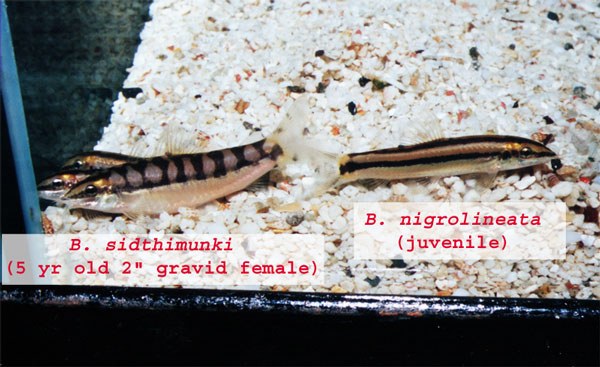Telling Ambastaia sidthimunki apart from A. nigrolineata

By Kamphol Udomritthiruj
Originally posted March 8th, 2000.
Nomenclature changes (Kottelat 2004) incorporated by Martin Thoene
Six years ago, at the suggestion of Ichthylogist Tyson Roberts, a friend and I went on an expedition to a watershed stream and village called Nam Wa in Nan Province, Northeastern Thailand. It was December and there in knee length cold water we observed flashes of what we thought were an undiscovered population of Ambastaia sidthimunki. With no seines, we asked the local villagers to catch some of the loaches for us. Incredibly, the villagers hand caught the loaches, trapping them under stones. And thus started a seasonal (winter) fishery that has continued until now of these "sidthimunkis". It became obvious, that these were not sidthimunki on three counts. One was the consistently strong horizontal lateral stripe that is exhibited by the majority of these loaches from Nan at all sizes (1 - 4 inches). Second, the original type specimens of sidthimunki and that prior to the fishery of the Nan giants 6 years ago, sidthimunkis never grew beyond 2 - 2.5 inches. They grew fat and gravid, and I've seen them as old as 10 yrs old, but they were always dwarf Botia. Third, the original sidthimunki come from Kanchanaburi Province from the Kwai River system in Western Thailand. Dams on the river system have caused their rumored extinction in the wild. All true sidthimunki in the trade today come from a single commercial breeding (induced breeding) operation and that is why they are rare in the trade.
The Nan giants are breeders that come upstream during the dry season (winter) to breed. As I write this, the sizes of these loaches will have reduced significantly and in the next 2 - 3 weeks, shipments to the US will be of smaller sizes (2 inches) which are caught further downstream.
The loaches from Nan also match the zoogeography in the distribution of Ambastaia nigrolineatus which is described from the Mekong River system. Without scientific verification, these are at best Ambastaia cf nigrolineata. They are however, definitely not sidthimunki on account of pattern, size, if not distribution. The Nan loaches are also much more difficult to keep in terms of keeping their body weight on. When freshly caught, the have proportionately small heads compared to their round full bodies and thick tails. In captivity, they slowly thin out and their heads become disproportionately larger than their body depth. It is a matter of high metabolism for these loaches which live in cool and fast flowing waters.
And to answer Mike Ophir's question, yes, after examining my preserved specimens of Nan A. cf. nigrolineata, there is a fourth pair of vestigial barbels on the chin, a mere pair of stumps.
The pictures below show comparisons of full-grown Kanchanaburi "true" A. sidthimunki and Nan Y. cf. nigrolineata, at 1.5 inches, at 2 inches and from the top, showing consistent differences in their dorsal striping.
Kamphol Udomritthiruj
(Editor's note) The photographs carry captions reflecting the name Botia as applied to these species at the time of original publication.



Additional information and pictures:
By Anuratana Tejavej
April 9th, 2000
Here are some low quality pictures of Yasuhikotakia cf. nigrolineata to complement the comparison between it and the Dwarf loach.
 |
| One of the more extensively patterned Nan loaches |
 |
| One of the fuller body Nan loaches. |
 |
| "Lineup" to compare the size and pattern differences between the "large" dwarf loach in the foreground and the around 3 1/2 inch Nan loach in the background. |
 |
From Graeme Robson: A.sidthimunki (TOP) A.nigrolineata (BOTTOM) |
| Additional photographs by Dave Rinaldo: |
 |
| Large group of adult Ambastaia sidthimunki with very bold markings |
 |
| Large group of Ambastaia nigrolineata. Note strong lateral stripe with little vertical striping below and much reduced "Chain" effect between the lateral and dorsal stripes. |

Document Actions

